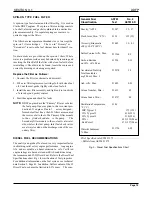
SECTION 1
DDFP
Page 1
PRINCIPLES OF OPERATION
The diesel engine is an internal comb ustion power unit, in
which the heat of fuel is converted into work in the cylinder
of the engine.
In the diesel engine, air alone is compressed in the cylinder;
then, after the air has been compressed, a charge of fuel is
sprayed into the c ylinder and ignition is accomplished by
the heat of compression.
The Two-Cycle Principle
In the tw o-cycle engine, intake and e xhaust functions tak e
place during part of the compression and po wer strokes re-
spectively (Fig. 1) or (Fig. 2). In contrast,
a four -cycle
engine requires four piston strokes to complete an operating
cycle; thus, during one half of its operation, the four-cycle
engine functions merely as an air pump.
A blo wer is pro vided to force air into the c
ylinders for
expelling the exhaust gases and to supply the cylinders with
fresh air for combustion. The cylinder wall contains a row of
ports which are above the piston when it is at the bottom of
its stroke. These ports admit the air from the blower into the
cylinder as soon as the rim of the piston unco vers the ports
(Fig. 1 & 2 - Scavenging).
The unidirectional flow of air toward the exhaust valves pro-
duces a scavenging effect, leaving the cylinders full of clean
air when the piston again covers the inlet ports.
As the piston continues on the upw ard stroke, the exhaust
valves close and the charge of fresh air is subjected to com-
pression (Fig. 1 & 2 - Compression).
Shortly before the piston reaches its highest position,
the
required amount of fuel is sprayed into the comb
ustion
chamber by the unit fuel injector (Fig. 1 & 2 - Po wer). The
intense heat generated during the high compression of the
air ignites the f ine fuel spray immediately. The combustion
continues until the fuel injected has been b urned.
The resulting pressure forces the piston do wnward on its
power stroke. The exhaust valves are again opened when the
piston is about half way down, allowing the burned gases to
escape into the e xhaust manifold (Fig. 1 & 2 - Exhaust).
Shortly thereafter , the do wnward mo ving piston unco vers
the inlet ports and the c ylinder is again swept with clean
scavenging air. This entire combustion cycle is completed in
each cylinder for each re volution of the crankshaft, or, in
other words, in two strokes; hence, it is a "two-stroke cycle".
Exhaust
Power
Compression
Scavenging
AIR
AIR
FUEL
AIR
AIR
AIR
12240
SCAVENGING
EXHAUST
POWER
COMPRESSION
AIR
AIR
AIR
AIR
FUEL
AIR
EXHAUST
Fig. 1 - In-Line Cylinder Arrangement
Fig. 2 - Vee Block Cylinder Arrangement
11826





































